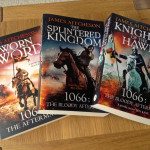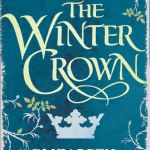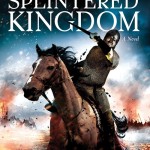“At Christmas the swineherd Garwulf brought me one of his fattest boars as a gift. We slaughtered it in the yard and roasted it over the hearth in my hall. The whole village came and we feasted like kings on its meat for three days, until there was nothing left but bone. There was drinking and there was dancing; the hall was hung with holly branches and the fire burnt brightly through those long nights.”
–Tancred, The Splintered Kingdom, ch. 17
To celebrate the festive season, and following the success of the competitions I ran earlier in the year, I’m pleased to announce that I’ll be running another series of giveaways. Starting on Monday 1st December, each week I’ll be offering up 2 signed copies of my books to lucky readers.
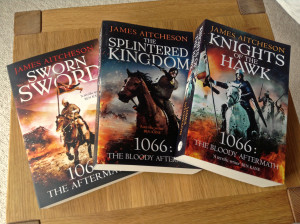
The complete Conquest Series set (so far…)
The rules are simple! The competition will run on Twitter, where you can already find me tweeting about 1066 and all things relating to the Middle Ages (@JamesAitcheson).
All you have to do in order to enter the prize draws and be in with a chance of winning is RT one of my competition tweets. You’ll be able to tell which ones they are, because they’ll look something like this:
RT for a chance to win one of 2 signed copies of Sworn Sword! #giveaway pic.twitter.com/H69vnaOymP
— James Aitcheson (@JamesAitcheson) December 1, 2014
Each week’s giveaway will run for 48 hours, from midday GMT on the Monday to 11.59am GMT on the Wednesday. You can enter as many times as you like during that time. The prize draws are open to UK residents only. Here’s what will be on offer each week:
Week 1
1-3 December
2 x signed paperback of Sworn Sword.
Week 2
8-10 December
2 x signed paperback of The Splintered Kingdom.
Week 3
15-17 December
2 x signed paperback of Knights of the Hawk.
At the close of each week’s giveaway I’ll use a random number generator to select the two lucky winners from all the entries received. I’ll post the results of the competitions both on Twitter and here on my blog, and will contact the winners via direct message (DM) so that they can send me their addresses.
Good luck, and happy tweeting!
This week on the blog I’m pleased to be interviewing award-winning and bestselling historical novelist Elizabeth Chadwick, whose latest novel, The Winter Crown, the second volume in her Eleanor of Aquitaine trilogy, has just been published in the UK.
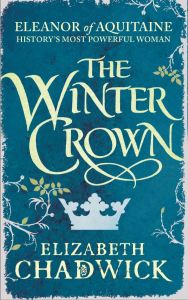
The Winter Crown • Elizabeth Chadwick • Sphere • 496 pp. • £16.99
Eleanor (or Alienor as she was called by contemporaries, and as she is referred to in the novels) was one of the most influential and powerful women in twelfth-century Europe: a woman about whom much has been written over the centuries, and who has been variously portrayed on both stage and screen. Many assumptions have been made about her and yet relatively little is definitively known, as Elizabeth points out in the afterword to the first book in the trilogy, The Summer Queen.
Queen firstly to Louis VII of France and later to Henry II of England, Eleanor became the mother of no fewer than ten children, including King Richard I and King John. Elizabeth’s magnificent series explores the full sweep of her life, beginning with her first marriage at the age of just thirteen and her introduction to the cut and thrust of politics at the royal court. She delves into Eleanor’s character and brings to life a world that in many ways is thoroughly alien to our own, but that in others is so very familiar.
Earlier this year, Elizabeth hosted a Q&A with me on her website to coincide with the publication of The Splintered Kingdom in the United States. I’m delighted today to be able to return the favour, and to welcome her to the blog.
*
Firstly, what is it about the twelfth century that fascinates you?
It goes back to when I was a teenager. I had told myself stories from the moment I had vocabulary. I can remember making up tales around children’s picture books. An illustration would appeal to me and I’d make up a story about it, a bit like the Mary Poppins film where Mary and the children jump into the chalk pavement pictures. I’d make up new adventures inside my favourite illustrations. I did this throughout my childhood and into my teens. Sometimes I would take visuals and inspirations from TV programmes – a photograph of the Star Trek crew from the Radio Times, a still from the BBC production of Vanity Fair or The Last of the Mohicans.
 As my teens advanced, the BBC put on a historical series titled the six wives of Henry VIII. I enjoyed this very much and began writing a Tudor story. However, that fell by the wayside after a few chapters. The following year the BBC screened a children’s programme titled Desert Crusader, dubbed from the French series Thibaud ou les Croisades. This was set in the Kingdom of Jerusalem and starred a knight of the mid-12th century, galloping round on his warhorse having exciting, sometimes romantic adventures. The hero to my fifteen year old self was truly gorgeous. I immediately began writing a novel with my protagonist loosely based on this character. Again rather like the chalk pictures, the story grew away from its origins and developed a complete life of its own. I didn’t know anything about the 12th century Holy Land so I had to head off to the library and begin researching. I wanted my story to feel as real as possible. Since my tale involved the hero returning to Europe, specifically to Angevin England, I had to research that aspect too, and that involved not only the political structure but all the detailed cultural background. I can remember being way too excited over finding a copy of Ewart Oakehott’s work on the archaeology of mediaeval weapons in the library and ignoring my A-level Tudor history homework to read up on 12th century swords!
As my teens advanced, the BBC put on a historical series titled the six wives of Henry VIII. I enjoyed this very much and began writing a Tudor story. However, that fell by the wayside after a few chapters. The following year the BBC screened a children’s programme titled Desert Crusader, dubbed from the French series Thibaud ou les Croisades. This was set in the Kingdom of Jerusalem and starred a knight of the mid-12th century, galloping round on his warhorse having exciting, sometimes romantic adventures. The hero to my fifteen year old self was truly gorgeous. I immediately began writing a novel with my protagonist loosely based on this character. Again rather like the chalk pictures, the story grew away from its origins and developed a complete life of its own. I didn’t know anything about the 12th century Holy Land so I had to head off to the library and begin researching. I wanted my story to feel as real as possible. Since my tale involved the hero returning to Europe, specifically to Angevin England, I had to research that aspect too, and that involved not only the political structure but all the detailed cultural background. I can remember being way too excited over finding a copy of Ewart Oakehott’s work on the archaeology of mediaeval weapons in the library and ignoring my A-level Tudor history homework to read up on 12th century swords!
Basically the more I read up on 12th century life and culture, the more I became interested in the period and the more I wanted to write stories set in that timeframe, so one fed off the other.
Do you think it’s an era that is sometimes overlooked?
I think it’s an era that is perhaps less mined than certain others, but it does have its share of novelists – my good friend Sharon Kay Penman for example. There are the Crowner John mysteries of Bernard Knight, or the novels of Ariana Franklin. And of course Pillars of the Earth by Ken Follett. It also has its share of meaty historical incidents – the Anarchy period of the war between Stephen and Matilda, the reign of Henry II and the murder of Thomas Beckett, the Third Crusade. It has towering characters such as the great William Marshal, the loved and loathed Richard the Lionheart, and ditto his brother Prince and then King John. It was a tumultuous period of history, but it’s not quite Tudor territory in terms of saturation, and it does take a dedicated amount of researching. Sometimes people will say it takes less research but that’s not true. It probably takes more to actually understand the period and you have to dig a lot deeper to find what you’re looking for.
You paint a fascinating and complex portrait of your subject, Eleanor of Aquitaine. What attracted you to her and inspired you to choose her as the focus of your latest trilogy?
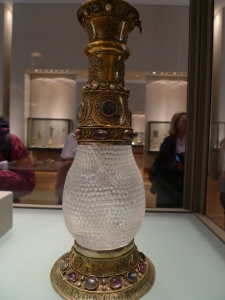
The Eleanor Vase, currently on display in the Louvre. It was given to Eleanor by her grandfather, William IX of Aquitaine, and she later gave it to her first husband, Louis VII of France as a marriage gift. (Photo credit: John Phillips.)
I was also interested in writing about Eleanor because scholarship is constantly turning up new information. For example, we now know she was more likely to have been 13 years old when she married, not 15 as has been earlier thought, and that puts a whole new slant on the way the character is portrayed. This is someone just out of childhood, a pawn in the power games of men, not a knowing, flirtatious older teenager as she has been so often portrayed. I felt there was a lot to be said that hasn’t been said before, and new, realistic ways of interpreting the material through the medium of fiction.
One of the things you do so well in the series is to bring to life the various conflicts, rivalries and alliances within the royal court. When dealing with so many characters, how do you keep track of all their relationships?
This is going to sound strange, I hope it doesn’t sound big headed – or perhaps I need a big head because the knowledge is all there in my mind! I sometimes have to pick up a reference book to check on a detail but on the whole it’s all there up top. I think it helps that I have been reading about and researching the period 1066-1220 since I was 15 and that’s a long time ago. It does mean that a lot of the history is already there and I can start researching from a strong, multi-layered bedrock. I do write a very detailed synopsis at the beginning of the novel and I can refer to this as a timeline so I guess that’s the skeleton part of the structure.
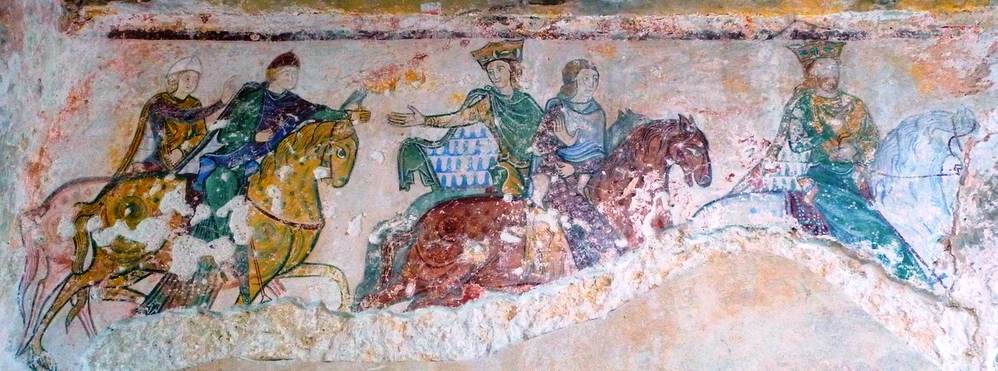
Mural depicting what is thought to be Henry II and his four sons in the chapel of St Radegonde at Chinon, Indre-et-Loire, France. (Photo credit: John Phillips.)
Some of the historical persons featured in your latest series may be familiar to readers of your earlier novels. Do you ever revise your opinion of particular characters, and does that affect how you portray them in your writing?
Yes. I think we are always learning. Personally, what might have been true of my knowledge 10 years ago may now have changed down to new historical discoveries or increased study and awareness on my part. I wrote a novel called The Champion which is one of my earlier slightly more romantic works where I cut Prince John a little more slack than I would now. But at the same time I probably understand more about John and his personality now and can bring that to bear when writing his character today, so he’d be more nuanced. Sometimes there’s a conundrum when a character has to change hair or eye colour because of new research but if that happens there’s always the author’s note to explain it. I wrote a couple of novels about the Bigod family – The Time of Singing and To Defy A King, where one of my characters, Roger Bigod goes through changes as he ages and life takes its toll on him. I’ve had readers say why is he so different from one novel to the next, but I don’t think he is. It’s just that we grow and change and perhaps become less flexible as we get older. So with a character, if one is being realistic, one has to take into account the changes wrought by time and experience. I go with the truest version I know at the point of writing and make up for discrepancies in the afterword should I need to.
Henry II and Eleanor ruled over a territory that famously stretched from the Scottish Borders to the Pyrenees. How did they maintain their authority over such far-flung lands?
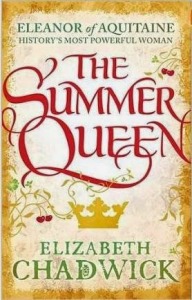
The Summer Queen, the first book in Elizabeth’s Eleanor of Aquitaine trilogy, is available now in paperback, published by Sphere.
Are there any reference books you can recommend for readers interested in finding out more about Eleanor and her world?
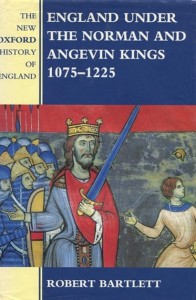
England under the Norman and Angevin Kings • Robert Bartlett
I understand that you are currently writing the final book in the trilogy, The Autumn Throne. What’s next for you?
I’ve discussed the next novels with my publisher, and I can say for definite that William Marshal and his family are once more on the cards. There are gaps in his life that need filling in and I’ve already started research into the background!
*
Many thanks, Elizabeth, for taking the time to talk about your work! The Winter Crown is available now in hardback and as an ebook, published by Sphere. The first book in the trilogy, The Summer Queen, is also available in paperback.
Recently I came across an article from Londonist, the online magazine, that featured a map of Anglo-Saxon London drawn by Matt Brown. It’s a terrific piece of work that depicts the geography of the area during the early Middle Ages and gives a sense of the sheer extent of the modern city. If you haven’t seen it yet, it’s definitely worth checking out. You can even download the full map to view offline.
On Thursday evening I posted a link to the map on my Facebook page. The following morning I found out that it had been shared by 19 people and reached an audience of 1,880. And that was just the start.
At the time of writing this article another two days later, the link has so far been shared no less than 171 times, and has been seen by more than 27,000 people on Facebook (see screengrab below).
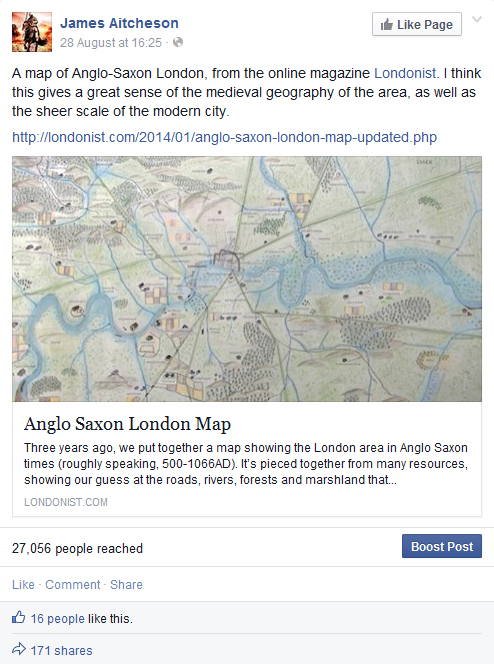
Screengrab taken from my Facebook page (31 August 2014) of the original post that included the link to Matt Brown’s map of Anglo-Saxon London.
In the grand scheme of things, maybe 27,000 isn’t a lot. What was impressive was the speed with which the link spread, firstly as my own followers shared it, and then as it was passed on by their friends, and their friends in turn, with people adding comments at each stage as they located places where they’d lived or grown up.
What’s great is that there are obviously a lot of people out there who are interested in London’s history. Not only that, but everyone who shared the link clearly saw within the map a personal connection that brought the history to life and gave it meaning for them.
For anyone who’s interested in finding out more, Matt’s written other articles for Londonist exploring how London’s rivers and boroughs got their names, which are well worth a read. (Clue: most of them derive from pre-Conquest, Old English roots, and some are older even than that.)
And I’ve written my own piece on the history of Anglo-Saxon London: a whistlestop journey through the centuries, following the city’s evolution from the end of the Roman period to the construction of the Tower of London after the Norman Conquest.
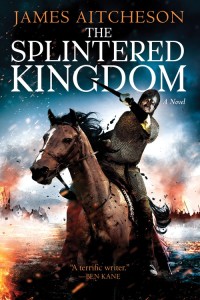
The Splintered Kingdom
James Aitcheson • Sourcebooks
416 pp. • Hardcover • $24.99
Many thanks to everyone who entered my recent giveaway on Twitter to celebrate the publication by Sourcebooks of Tancred’s second adventure, The Splintered Kingdom.
Five lucky winners of the prize draw were selected using a random number generator. Each will each receive a signed copy of the book in hardcover. Without further ado, then, here they are:
@Serhawk09
@sospokejessie
@FlowerFunTime
@JMAucoin_Writer
@hippolee999
Congratulations to the winners – I’ll be contacting you directly on Twitter. If you didn’t win, better luck next time! You can console yourself with the knowledge that The Splintered Kingdom is on sale now, available from all good bookstores and online, both in hardcover and as an ebook.

The Splintered Kingdom
James Aitcheson • Sourcebooks
416 pp. • Hardcover • $24.99
The rules are simple! The competition will run on Twitter, where you can already find me tweeting about 1066 and all things relating to the Middle Ages (@JamesAitcheson).
All you have to do to enter the prize draw and be in with a chance of winning is to RT one of my competition tweets. You’ll be able to tell which ones they are, because they’ll include the hashtag #giveaway.
Entries are limited to those living in the U.S. and Canada. The competition will close at 11.59am EDT on Thursday, August 14th. At that point I’ll use a random number generator to select five winners.
I’ll post the results of the competition both on Twitter and here on my blog, and will contact the winners via direct message (DM) so that they can send me their addresses.
Good luck, and happy tweeting!
“They came at first light, when the eastern skies were still gray and before anyone on the manor had risen. Shadows lay across the land: across the hall upon the mound and the fields surrounding it, across the river and the woods and the great dyke beyond that runs from sea to sea. And it was from those shadows that they came upon Earnford, with swords and knives and axes…”

The Splintered Kingdom
James Aitcheson • Sourcebooks
416 pp. • Hardcover • $24.99
Set in England in 1070, one year on from the end of Sworn Sword, it once more features the ambitious Norman knight Tancred, who has been rewarded for his exploits with a lordship in the turbulent Welsh borderlands. But his hard-fought gains are soon placed in peril as a coalition of enemies both old and new prepares to march against King William. With English, Welsh and Viking forces gathering and war looming, Tancred is chosen to spearhead a perilous expedition. Success will bring him glory beyond his dreams; failure will mean the ruin of the reputation he has worked so hard to forge. As shield walls clash and the kingdom burns, not only his Tancred’s destiny at stake, but also that of England itself.
Like all my novels, The Splintered Kingdom can be read as a standalone adventure, so you don’t necessarily have to read Sworn Sword first in order to follow what’s going on. As always, e-book editions are available on all platforms for the more digitally inclined. Both the physical and the electronic versions also include a sneak preview of the third novel in the series, Knights of the Hawk, which is already scheduled to be published by Sourcebooks Landmark in 2015.
If you’re interested in finding more about the Welsh borderlands, where The Splintered Kingdom takes place, I’ve just published a mini-history of the region in the Tancred’s England section of my website – my historical guide to England as it was c.1066. It’s a project that I’m constantly developing and which I’m looking to expand over the coming months, with entries on some of the other places visited by Tancred in the course of his travels.

